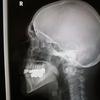Dr. V.S. Ramachandran appears in the following:
Phineas Gage and Please Explain: Anger
Monday, April 04, 2011
During Friday’s Please Explain about anger, Dr. Philip Muskin brought up a man named Phineas Gage, who, he said, “was a very responsible manager on the railroad. One day a tamping rod went through his eye, through his brain, and basically gave him a frontal lobotomy. And Phineas Gage then became basically a ne’er do well. He was not responsible, he drank, he caroused, he lost his temper all the time. That is, the connection between the prefrontal cortex and the rest of the brain is really important.”
Phineas Gage was 25 in 1848, and the foreman of a crew building a new railroad track in Vermont. He was packing explosives with a tamping iron that was “43 inches long, 1.25 inches in diameter and weighing 13.25 pounds,” according Steve Twomey, writing in Smithsonian magazine, when an explosion shot the tamping iron through his head—it entered through his cheek and exited through the top of his skull. He survived, but his doctor and friends noticed a remarkable change in his personality in the months following the accident. He became the most famous patient in neuroscience because his injury demonstrated a connection between brain trauma and personality change and showed that specific parts of the brain were responsible for our moods. Read more about Phineas Gage—and see a photograph of him with the tamping iron that injured him—in Smithsonian Magazine.
In February, Dr. V. S. Ramachandran spoke with Leonard about his work in neuroscience, and he described how strokes cause brain trauma that can alter senses and change personalities. One patient started drawing with incredible detail after he suffered a stroke, although he was never particularly interested in or skilled at making art before. In Dr. Ramachandran's book The Tell-Tale Brain, he gives a number of examples of how brain injuries reveal the ways the brain works. You can listen to that interview here.
The Tell-Tale Brain
Thursday, February 03, 2011
Physician and researcher Dr. V. S. Ramachandran draws on strange case studies to offer insight into the evolution of the uniquely human brain. In The Tell-Tale Brain: A Neuroscientist's Quest for What Makes Us Human, he reveals what these cases teach us about how language developed, what the origins of art are, what causes autism, and how we develop self-awareness.
Soft Drinks, Harsh Results
Tuesday, July 24, 2007
No Special Now
Tuesday, July 24, 2007
Beyond Time
Tuesday, July 24, 2007
Who Am I?
Monday, May 07, 2007
Mirror Neurons
Friday, December 01, 2006
It would be hard to write a novel - or read one - without the ability to empathize. Recent discoveries tell us that empathy may be hard-wired in our brains. V.S. Ramachandran, who teaches neuroscience at the University of California, San Diego, explains how mirror neurons ...





